Analyzing Milo's Marketing Strategy: Brand Community & Identity
VerifiedAdded on 2023/06/11
|8
|1393
|97
Report
AI Summary
This report analyzes Milo's marketing strategy, focusing on the creation of a brand community and the leveraging of social identity theory. It examines Milo's initiative to introduce children to cricket in Australia and how this program fosters brand identification, community engagement, and a sense of moral responsibility. The report also discusses the importance of shared consciousness, rituals, and traditions in building a strong brand community, leading to increased customer loyalty, satisfaction, trust, and commitment. Furthermore, it highlights the shift towards marketing participation, emphasizing honesty, mutual benefit, and the creation of a sense of value for consumers. This strategy allows Milo to connect with customers on a deeper level, fostering brand recognition and social empowerment through sports.

1
Marketing System
Name:
Course
Professor’s name
University name
City, State
Date of submission
Marketing System
Name:
Course
Professor’s name
University name
City, State
Date of submission
Paraphrase This Document
Need a fresh take? Get an instant paraphrase of this document with our AI Paraphraser
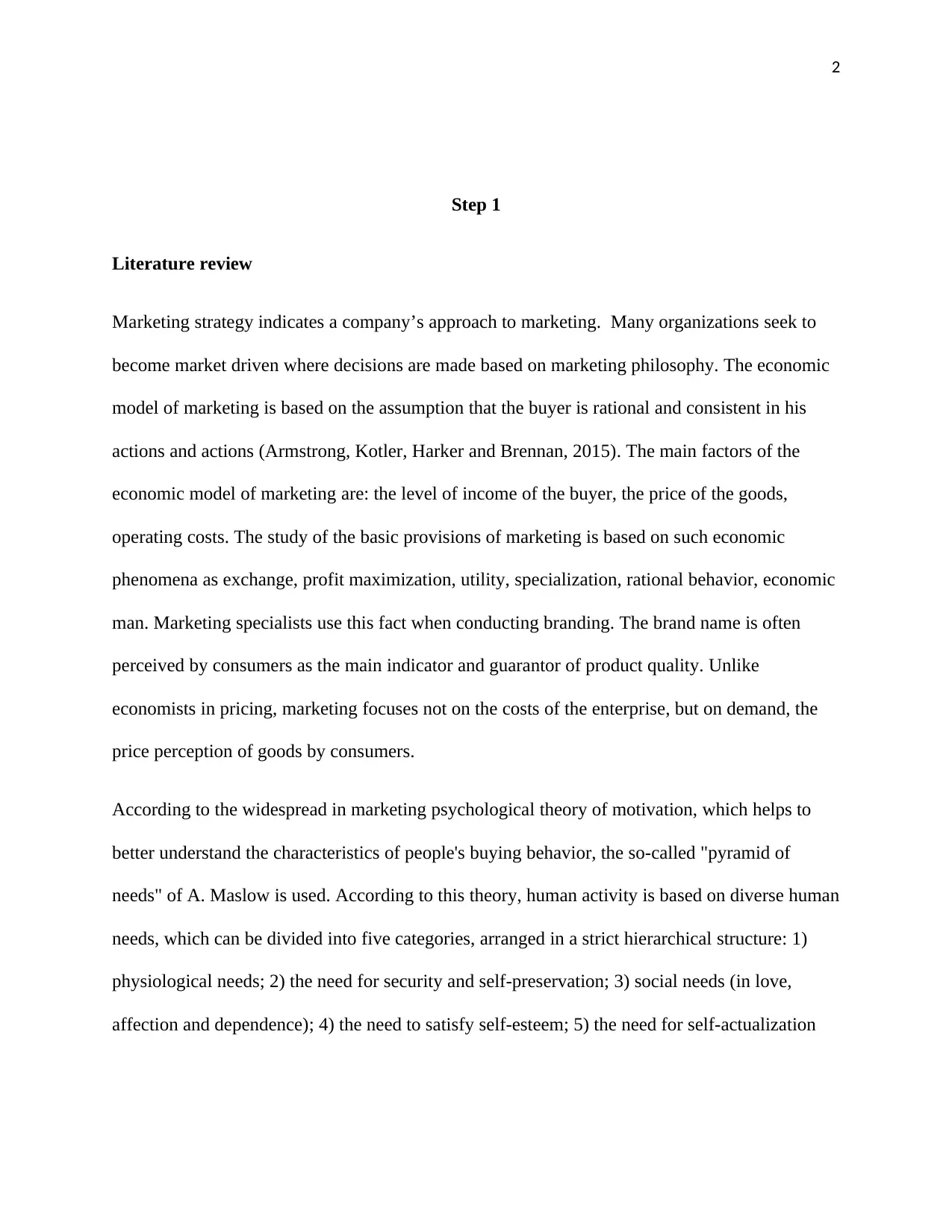
2
Step 1
Literature review
Marketing strategy indicates a company’s approach to marketing. Many organizations seek to
become market driven where decisions are made based on marketing philosophy. The economic
model of marketing is based on the assumption that the buyer is rational and consistent in his
actions and actions (Armstrong, Kotler, Harker and Brennan, 2015). The main factors of the
economic model of marketing are: the level of income of the buyer, the price of the goods,
operating costs. The study of the basic provisions of marketing is based on such economic
phenomena as exchange, profit maximization, utility, specialization, rational behavior, economic
man. Marketing specialists use this fact when conducting branding. The brand name is often
perceived by consumers as the main indicator and guarantor of product quality. Unlike
economists in pricing, marketing focuses not on the costs of the enterprise, but on demand, the
price perception of goods by consumers.
According to the widespread in marketing psychological theory of motivation, which helps to
better understand the characteristics of people's buying behavior, the so-called "pyramid of
needs" of A. Maslow is used. According to this theory, human activity is based on diverse human
needs, which can be divided into five categories, arranged in a strict hierarchical structure: 1)
physiological needs; 2) the need for security and self-preservation; 3) social needs (in love,
affection and dependence); 4) the need to satisfy self-esteem; 5) the need for self-actualization
Step 1
Literature review
Marketing strategy indicates a company’s approach to marketing. Many organizations seek to
become market driven where decisions are made based on marketing philosophy. The economic
model of marketing is based on the assumption that the buyer is rational and consistent in his
actions and actions (Armstrong, Kotler, Harker and Brennan, 2015). The main factors of the
economic model of marketing are: the level of income of the buyer, the price of the goods,
operating costs. The study of the basic provisions of marketing is based on such economic
phenomena as exchange, profit maximization, utility, specialization, rational behavior, economic
man. Marketing specialists use this fact when conducting branding. The brand name is often
perceived by consumers as the main indicator and guarantor of product quality. Unlike
economists in pricing, marketing focuses not on the costs of the enterprise, but on demand, the
price perception of goods by consumers.
According to the widespread in marketing psychological theory of motivation, which helps to
better understand the characteristics of people's buying behavior, the so-called "pyramid of
needs" of A. Maslow is used. According to this theory, human activity is based on diverse human
needs, which can be divided into five categories, arranged in a strict hierarchical structure: 1)
physiological needs; 2) the need for security and self-preservation; 3) social needs (in love,
affection and dependence); 4) the need to satisfy self-esteem; 5) the need for self-actualization
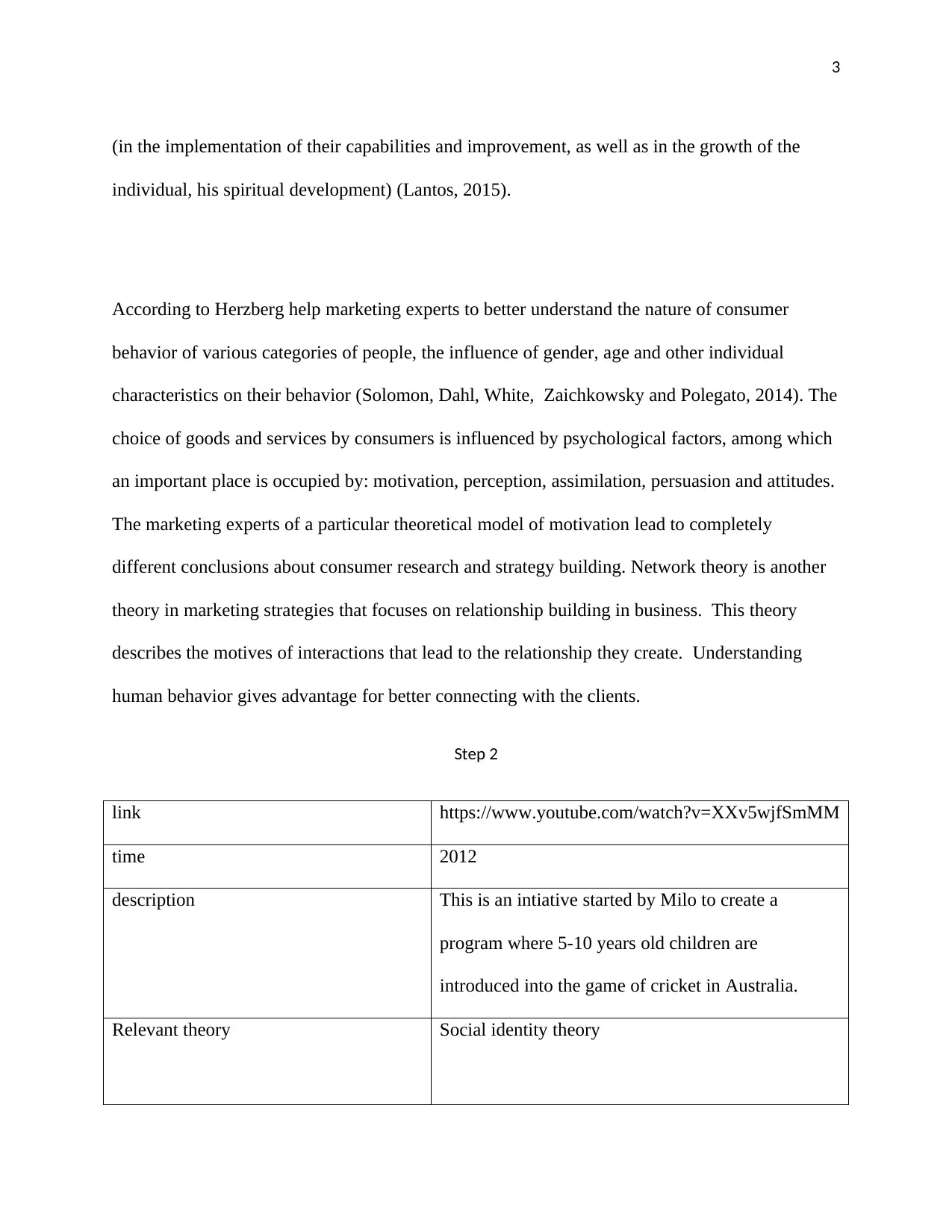
3
(in the implementation of their capabilities and improvement, as well as in the growth of the
individual, his spiritual development) (Lantos, 2015).
According to Herzberg help marketing experts to better understand the nature of consumer
behavior of various categories of people, the influence of gender, age and other individual
characteristics on their behavior (Solomon, Dahl, White, Zaichkowsky and Polegato, 2014). The
choice of goods and services by consumers is influenced by psychological factors, among which
an important place is occupied by: motivation, perception, assimilation, persuasion and attitudes.
The marketing experts of a particular theoretical model of motivation lead to completely
different conclusions about consumer research and strategy building. Network theory is another
theory in marketing strategies that focuses on relationship building in business. This theory
describes the motives of interactions that lead to the relationship they create. Understanding
human behavior gives advantage for better connecting with the clients.
Step 2
link https://www.youtube.com/watch?v=XXv5wjfSmMM
time 2012
description This is an intiative started by Milo to create a
program where 5-10 years old children are
introduced into the game of cricket in Australia.
Relevant theory Social identity theory
(in the implementation of their capabilities and improvement, as well as in the growth of the
individual, his spiritual development) (Lantos, 2015).
According to Herzberg help marketing experts to better understand the nature of consumer
behavior of various categories of people, the influence of gender, age and other individual
characteristics on their behavior (Solomon, Dahl, White, Zaichkowsky and Polegato, 2014). The
choice of goods and services by consumers is influenced by psychological factors, among which
an important place is occupied by: motivation, perception, assimilation, persuasion and attitudes.
The marketing experts of a particular theoretical model of motivation lead to completely
different conclusions about consumer research and strategy building. Network theory is another
theory in marketing strategies that focuses on relationship building in business. This theory
describes the motives of interactions that lead to the relationship they create. Understanding
human behavior gives advantage for better connecting with the clients.
Step 2
link https://www.youtube.com/watch?v=XXv5wjfSmMM
time 2012
description This is an intiative started by Milo to create a
program where 5-10 years old children are
introduced into the game of cricket in Australia.
Relevant theory Social identity theory
⊘ This is a preview!⊘
Do you want full access?
Subscribe today to unlock all pages.

Trusted by 1+ million students worldwide
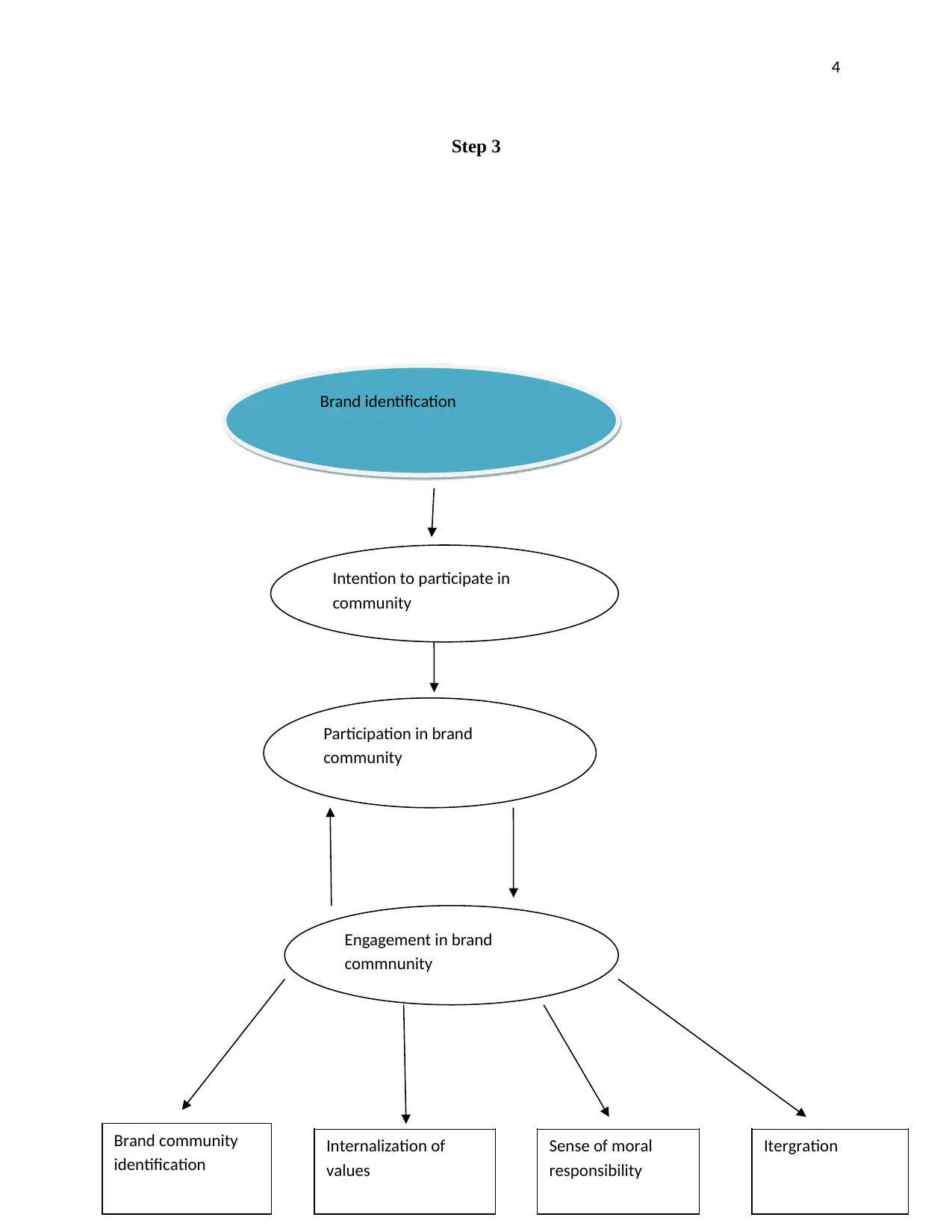
4
Step 3
Brand identification
Intention to participate in
community
Participation in brand
community
Engagement in brand
commnunity
Brand community
identification
Internalization of
values
Sense of moral
responsibility
Itergration
Step 3
Brand identification
Intention to participate in
community
Participation in brand
community
Engagement in brand
commnunity
Brand community
identification
Internalization of
values
Sense of moral
responsibility
Itergration
Paraphrase This Document
Need a fresh take? Get an instant paraphrase of this document with our AI Paraphraser
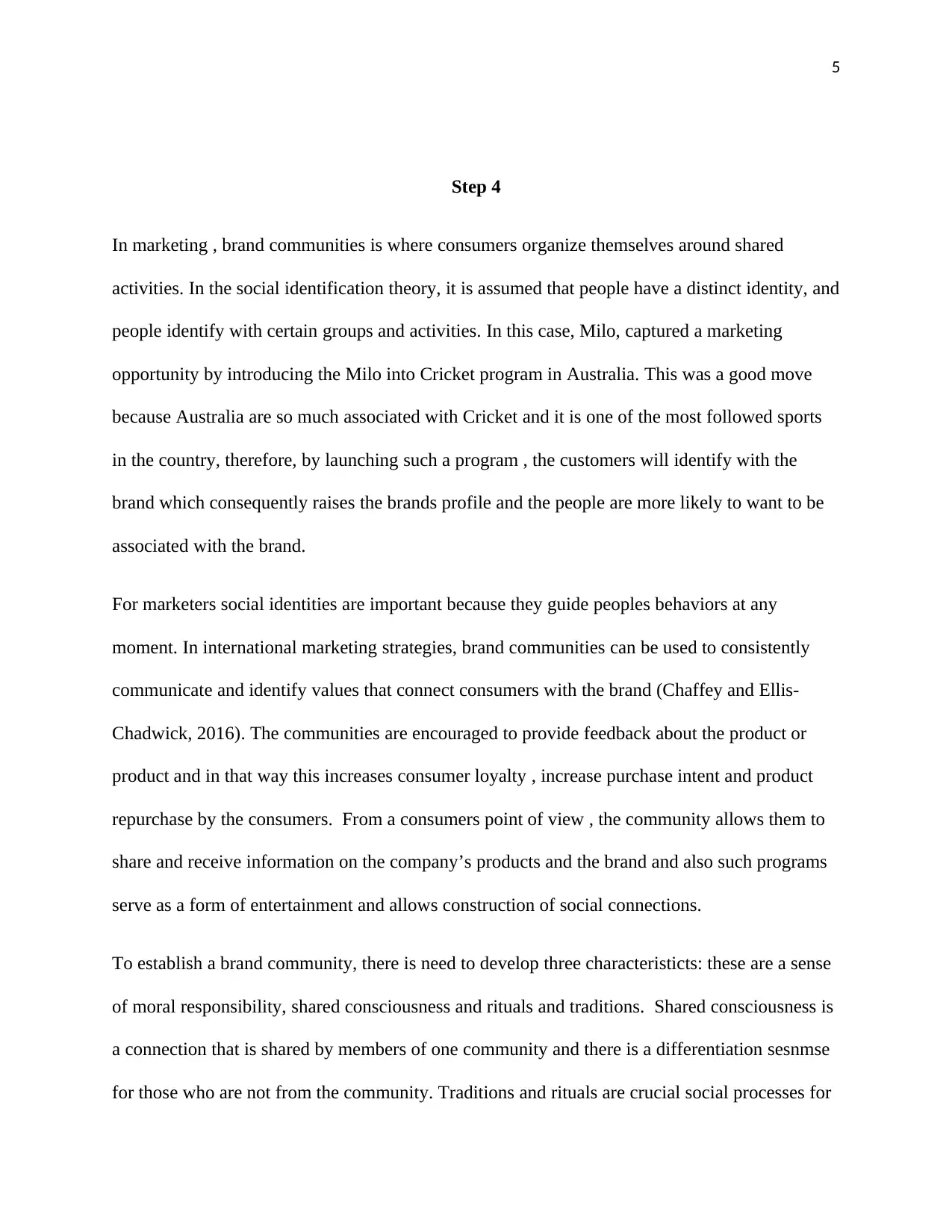
5
Step 4
In marketing , brand communities is where consumers organize themselves around shared
activities. In the social identification theory, it is assumed that people have a distinct identity, and
people identify with certain groups and activities. In this case, Milo, captured a marketing
opportunity by introducing the Milo into Cricket program in Australia. This was a good move
because Australia are so much associated with Cricket and it is one of the most followed sports
in the country, therefore, by launching such a program , the customers will identify with the
brand which consequently raises the brands profile and the people are more likely to want to be
associated with the brand.
For marketers social identities are important because they guide peoples behaviors at any
moment. In international marketing strategies, brand communities can be used to consistently
communicate and identify values that connect consumers with the brand (Chaffey and Ellis-
Chadwick, 2016). The communities are encouraged to provide feedback about the product or
product and in that way this increases consumer loyalty , increase purchase intent and product
repurchase by the consumers. From a consumers point of view , the community allows them to
share and receive information on the company’s products and the brand and also such programs
serve as a form of entertainment and allows construction of social connections.
To establish a brand community, there is need to develop three characteristicts: these are a sense
of moral responsibility, shared consciousness and rituals and traditions. Shared consciousness is
a connection that is shared by members of one community and there is a differentiation sesnmse
for those who are not from the community. Traditions and rituals are crucial social processes for
Step 4
In marketing , brand communities is where consumers organize themselves around shared
activities. In the social identification theory, it is assumed that people have a distinct identity, and
people identify with certain groups and activities. In this case, Milo, captured a marketing
opportunity by introducing the Milo into Cricket program in Australia. This was a good move
because Australia are so much associated with Cricket and it is one of the most followed sports
in the country, therefore, by launching such a program , the customers will identify with the
brand which consequently raises the brands profile and the people are more likely to want to be
associated with the brand.
For marketers social identities are important because they guide peoples behaviors at any
moment. In international marketing strategies, brand communities can be used to consistently
communicate and identify values that connect consumers with the brand (Chaffey and Ellis-
Chadwick, 2016). The communities are encouraged to provide feedback about the product or
product and in that way this increases consumer loyalty , increase purchase intent and product
repurchase by the consumers. From a consumers point of view , the community allows them to
share and receive information on the company’s products and the brand and also such programs
serve as a form of entertainment and allows construction of social connections.
To establish a brand community, there is need to develop three characteristicts: these are a sense
of moral responsibility, shared consciousness and rituals and traditions. Shared consciousness is
a connection that is shared by members of one community and there is a differentiation sesnmse
for those who are not from the community. Traditions and rituals are crucial social processes for
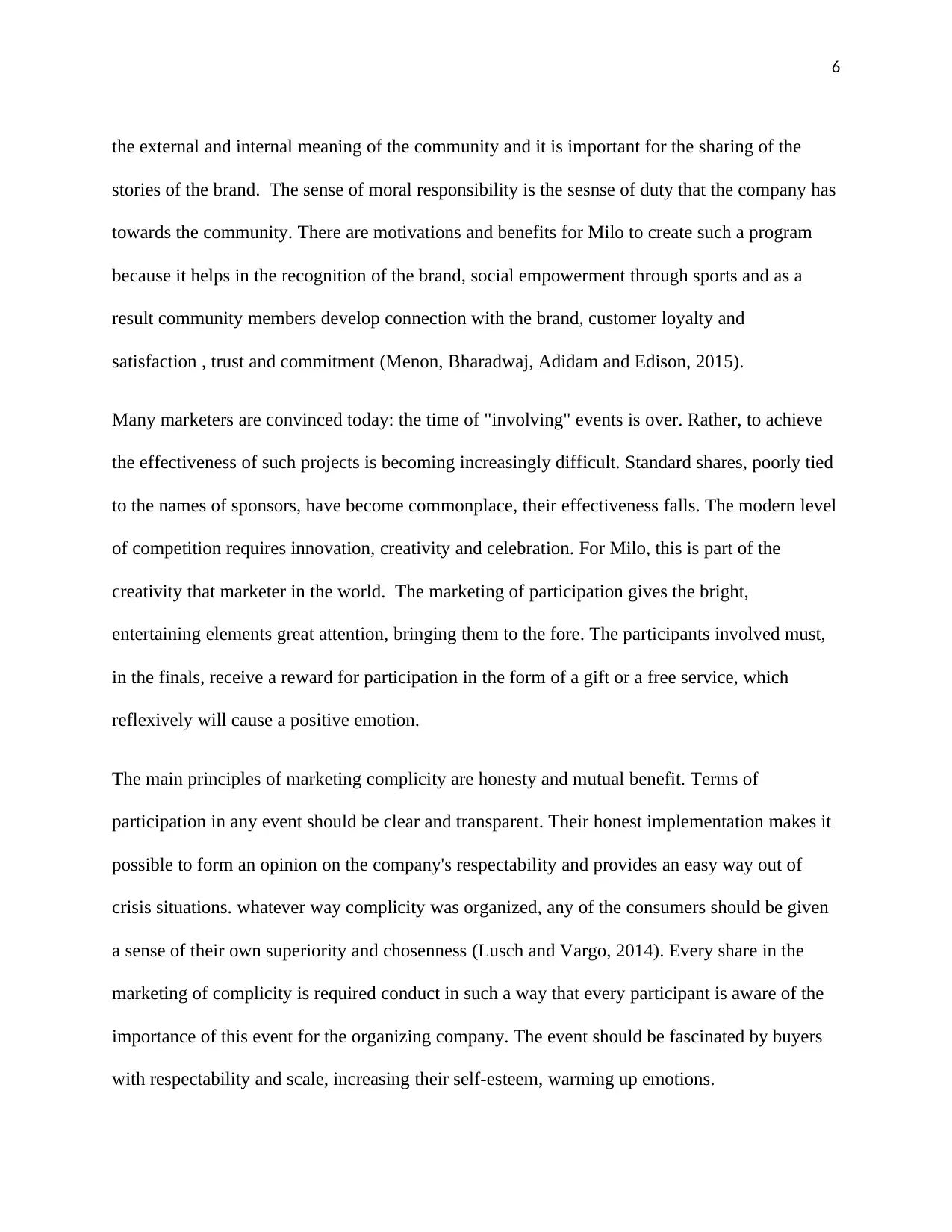
6
the external and internal meaning of the community and it is important for the sharing of the
stories of the brand. The sense of moral responsibility is the sesnse of duty that the company has
towards the community. There are motivations and benefits for Milo to create such a program
because it helps in the recognition of the brand, social empowerment through sports and as a
result community members develop connection with the brand, customer loyalty and
satisfaction , trust and commitment (Menon, Bharadwaj, Adidam and Edison, 2015).
Many marketers are convinced today: the time of "involving" events is over. Rather, to achieve
the effectiveness of such projects is becoming increasingly difficult. Standard shares, poorly tied
to the names of sponsors, have become commonplace, their effectiveness falls. The modern level
of competition requires innovation, creativity and celebration. For Milo, this is part of the
creativity that marketer in the world. The marketing of participation gives the bright,
entertaining elements great attention, bringing them to the fore. The participants involved must,
in the finals, receive a reward for participation in the form of a gift or a free service, which
reflexively will cause a positive emotion.
The main principles of marketing complicity are honesty and mutual benefit. Terms of
participation in any event should be clear and transparent. Their honest implementation makes it
possible to form an opinion on the company's respectability and provides an easy way out of
crisis situations. whatever way complicity was organized, any of the consumers should be given
a sense of their own superiority and chosenness (Lusch and Vargo, 2014). Every share in the
marketing of complicity is required conduct in such a way that every participant is aware of the
importance of this event for the organizing company. The event should be fascinated by buyers
with respectability and scale, increasing their self-esteem, warming up emotions.
the external and internal meaning of the community and it is important for the sharing of the
stories of the brand. The sense of moral responsibility is the sesnse of duty that the company has
towards the community. There are motivations and benefits for Milo to create such a program
because it helps in the recognition of the brand, social empowerment through sports and as a
result community members develop connection with the brand, customer loyalty and
satisfaction , trust and commitment (Menon, Bharadwaj, Adidam and Edison, 2015).
Many marketers are convinced today: the time of "involving" events is over. Rather, to achieve
the effectiveness of such projects is becoming increasingly difficult. Standard shares, poorly tied
to the names of sponsors, have become commonplace, their effectiveness falls. The modern level
of competition requires innovation, creativity and celebration. For Milo, this is part of the
creativity that marketer in the world. The marketing of participation gives the bright,
entertaining elements great attention, bringing them to the fore. The participants involved must,
in the finals, receive a reward for participation in the form of a gift or a free service, which
reflexively will cause a positive emotion.
The main principles of marketing complicity are honesty and mutual benefit. Terms of
participation in any event should be clear and transparent. Their honest implementation makes it
possible to form an opinion on the company's respectability and provides an easy way out of
crisis situations. whatever way complicity was organized, any of the consumers should be given
a sense of their own superiority and chosenness (Lusch and Vargo, 2014). Every share in the
marketing of complicity is required conduct in such a way that every participant is aware of the
importance of this event for the organizing company. The event should be fascinated by buyers
with respectability and scale, increasing their self-esteem, warming up emotions.
⊘ This is a preview!⊘
Do you want full access?
Subscribe today to unlock all pages.

Trusted by 1+ million students worldwide

7
References
References
Paraphrase This Document
Need a fresh take? Get an instant paraphrase of this document with our AI Paraphraser
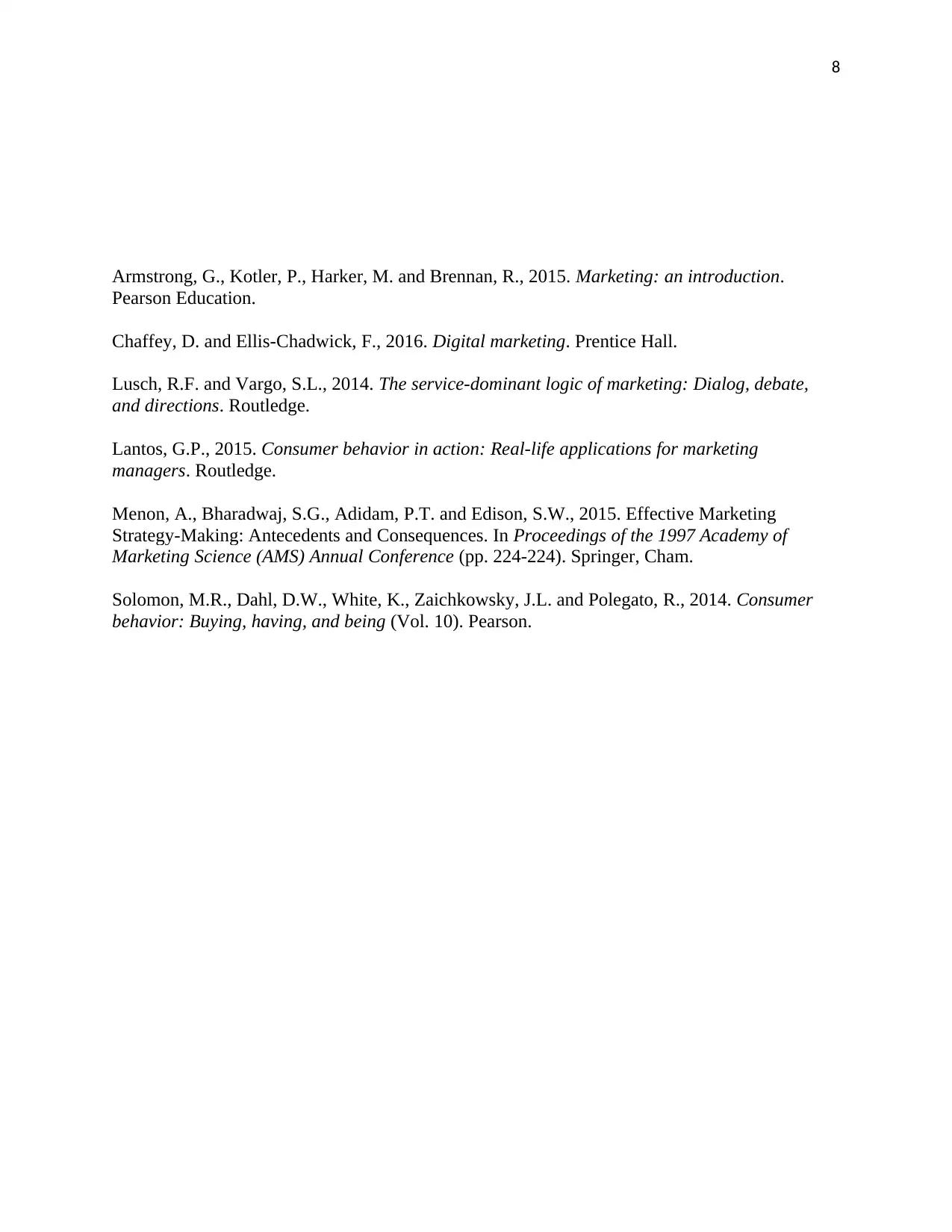
8
Armstrong, G., Kotler, P., Harker, M. and Brennan, R., 2015. Marketing: an introduction.
Pearson Education.
Chaffey, D. and Ellis-Chadwick, F., 2016. Digital marketing. Prentice Hall.
Lusch, R.F. and Vargo, S.L., 2014. The service-dominant logic of marketing: Dialog, debate,
and directions. Routledge.
Lantos, G.P., 2015. Consumer behavior in action: Real-life applications for marketing
managers. Routledge.
Menon, A., Bharadwaj, S.G., Adidam, P.T. and Edison, S.W., 2015. Effective Marketing
Strategy-Making: Antecedents and Consequences. In Proceedings of the 1997 Academy of
Marketing Science (AMS) Annual Conference (pp. 224-224). Springer, Cham.
Solomon, M.R., Dahl, D.W., White, K., Zaichkowsky, J.L. and Polegato, R., 2014. Consumer
behavior: Buying, having, and being (Vol. 10). Pearson.
Armstrong, G., Kotler, P., Harker, M. and Brennan, R., 2015. Marketing: an introduction.
Pearson Education.
Chaffey, D. and Ellis-Chadwick, F., 2016. Digital marketing. Prentice Hall.
Lusch, R.F. and Vargo, S.L., 2014. The service-dominant logic of marketing: Dialog, debate,
and directions. Routledge.
Lantos, G.P., 2015. Consumer behavior in action: Real-life applications for marketing
managers. Routledge.
Menon, A., Bharadwaj, S.G., Adidam, P.T. and Edison, S.W., 2015. Effective Marketing
Strategy-Making: Antecedents and Consequences. In Proceedings of the 1997 Academy of
Marketing Science (AMS) Annual Conference (pp. 224-224). Springer, Cham.
Solomon, M.R., Dahl, D.W., White, K., Zaichkowsky, J.L. and Polegato, R., 2014. Consumer
behavior: Buying, having, and being (Vol. 10). Pearson.
1 out of 8
Related Documents
Your All-in-One AI-Powered Toolkit for Academic Success.
+13062052269
info@desklib.com
Available 24*7 on WhatsApp / Email
![[object Object]](/_next/static/media/star-bottom.7253800d.svg)
Unlock your academic potential
Copyright © 2020–2025 A2Z Services. All Rights Reserved. Developed and managed by ZUCOL.





